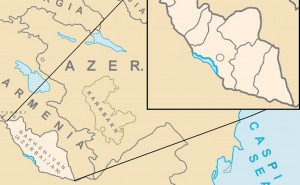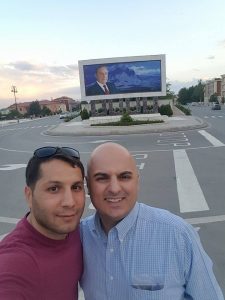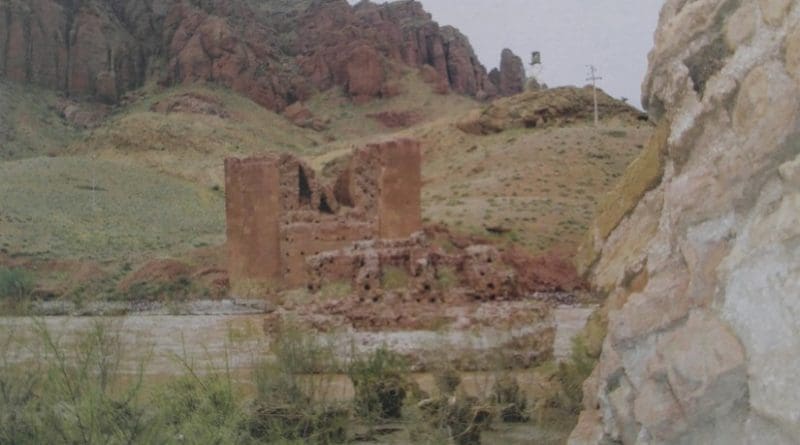Azerbaijan’s Cultural And Religious Landscape Of Gazakh And Nakhchivan Regions – OpEd
By Peter Tase
The Republic of Azerbaijan has preserved and played a fundamental role in preserving Islamic Culture, indigenous ethnic heritage and local Architecture, it is a cradle of civilization, home of Gülüstan Monument, Noah’s Mausoleum and of Momine Khatun Mausoleum in Nakhchivan.
Moreover the ‘Land of Fire and Pomegranates’ has become a special tourist destination where visitors appreciate unique urban developments, a synergy of western and eastern architecture, natural beauty and outstanding hospitality offered in Azerbaijan’s oldest cities, spiced up by carpet museums and unforgettable tasting of Kurdamir’s locally made wine and the creamy goat cheese of Jalilabad.

The writings of Sabir in Baku and of Jalil Mammadguluzadeh in Nakhchivan, embody the very essence of highly acclaimed patriotic movements and hardships of the Azerbaijani People, describe the country’s historic landmarks as well as its remarkable multiculturalism tradition that goes back many centuries.
The beautiful mountainous landscapes of the Caucasus, impressive cultural heritage sites, and unique Islamic Cultural sites are the highlight on every major city and district of Azerbaijan, some of them are, while impossible to mention all; the Cities of Gazakh and Nakhchivan Autonomous Republic are the focus of today.
The City of Gazakh is a special place where visitors will appreciate listening to traditional Azerbaijani songs. Only a few years ago Gazakh was established as the capital city of Azerbaijani Folklore; it was founded in the VIII Century by Marvan ibn Mahammad a Military Commander.
According to G. Voroshityasel, a researcher of ancient Azerbaijani language: “Gazakh is a very old town. Documents written in the IX – X Centuries make reference to Gazakh that the city had existed 1,270 years ago.” In the late XV Century, Gazakh Sultanate was established and it included Garabag beylerbeyi, under the rule of the Safavid Dinasty. The District of Gazakh is also known for its carpets; they are absolutely beautiful and certainly decorate the royal palaces of Norway and Denmark.
The designs and patters of these carpets are included in the paintings of famous Italian renaissance artists, including: Carlo Crivelli and Domenico di Bartolo, Pinturicchio and in the works of Dutch painter Jan van Eyk. The carpets of Gazakh are exhibited at the most prestigious museums in the Americas, Europe and Asia, among them is the Hermitage, the New York Metropolitan Museum, the Berlin Museum of Art, the Budapest Museum of Decorative Arts and many others.
After Gazakh, I headed to Nakhchivan Autonomous Republic, via plane through Baku. Azerbaijan Airlines offers a top notch daily service to Nakhchivan city and the flight has a duration of approximately 90 minutes. At the airport I was welcomed by the Natig Travel Executives, Emil and Natig, two bright, young Nakhchivani entrepreneurs. I spent a few days in Nakhchivan, hosted by Tebriz Hotel in Nakhchivan and its impeccable amenities; during this time I was exposed to an enriching experience of the western most Azerbaijani province. Whether visiting the astonishing Alinja fortress, Noah’s final resting place and mausoleum or the iconic Haca Dag, this autonomous Republic of Nakhchivan (Azerbaijan) did not fail to surprise and astound my colleagues and myself.

Our trip to Nakhchivan would have been incomplete, scarcely equipped with historic information had we not been guided in a professional manner by Emil and Natig, two bright Nakhchivan-history guides of Natig Travel. I have travelled to many unique places and have experienced a number of tour agencies and trust me – these young professionals were seamless, from the beginning to the last moment, taking great care to ensure that our arrival/departures were without any obstacles and made sure that we felt welcomed and at home during our stay in Nakhchivan.
Due to their many years of experience in tourism and working with prestigious organizations throughout the region, Natig Travel is without doubt the best tour guide company to use in Azerbaijan and Nakhchivan. Emil will take the time to explain the unique (and largely unknown) history of Nakhchivan such as its separation from Azerbaijan by the Bolsheviks in the 1920s and the consequences of the Treaty of Turkmenchay (1828), which established the modern day borders of Nakhchivan and Iran …and much more data for history buffs.
If you are in Baku and visiting Azerbaijan don’t miss out on the opportunity to come to Nakhchivan for even a few days. I assure you that you will not regret it! Furthermore with Emil and Natig we visited Shahbuz and Kangarli Regions, both located in the Autonomous Republic of Nakhchivan.
In the village of Guney Gishlag, Shahbuz Region, is located a cemetery that carries the village’s name. This ancient cemetery contains headstones, some of the graves are surrounded with little stones and others are covered with large size lime stones. This cemetery has mysteries that wait to be discovered by international historians, it has embraced a valuable heritage that speaks volumes in relation to Nakhchivan’s ancient illustrious past. On most of the head stones there are inscriptions written in Arabic language and numbers. Some of the headstones date back in the XI century, clarifying once again the ancient Turkic origins of these lands. According to the local inscriptions, and archaeological findings, this grave site dates back to the XI Century AD.
On the other hand, the Kangarli Region, in addition to its wealth of seven different types of marble (exported to Europe and Middle Eastern countries), is well known for its Gunorta Stone (Gunortaj); a natural monument located at 1,500 meters above sea level, on the western slopes of Chalkhandagh. The locals call this natural monument as Gunortaj, because it is covered with the Sun’s shadow up until gunorta (afternoon) and exactly in the afternoon its shadow disappears.
Indeed, each cultural and natural domain in these territories of Azerbaijan represents unique pictorial languages, cultural peculiarities and architectural masterpieces. In Nakhchivan – Azerbaijan, tourists will experience a reflection of a wealth of literary works including those of Nizami Ganjavi, Hafiz and Sa’di, who have provided a tremendous symbolic expression of Azerbaijani multiculturalism in their verses and harnessed a continuously refined Islamic culture that is vivid until today from the Autonomous Republic of Nakhchivan (Azerbaijan) to Absheron District.


7 types of marble? Wow, an interesting fact. It seems like this country is rich not only in its oil.